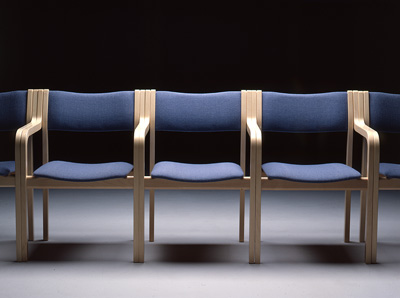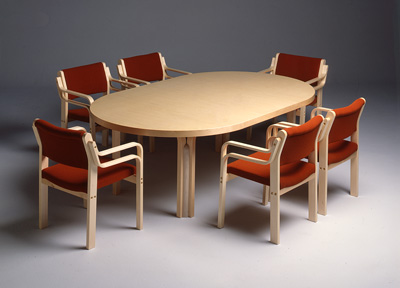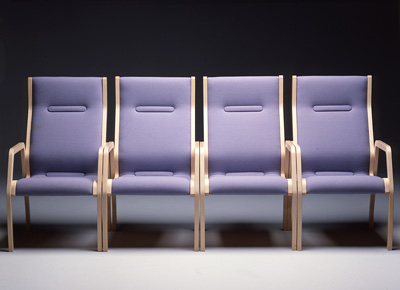

| HOME | Exhibitons: |
The Kari chair designed by Kari Asikainen for the Huonekalutehdas Korhonen Oy started its world conquest in 1969. The chair has been furnishing public premises in Finland for over 40 years, which is a long time for a chair model. The Kari chair has reached the appreciated status of a classic. It is an example of a product that has found its place in the market with its own qualifications without showy advertising campaigns. The chair can be seen as the result of the working cooperation of the designer and the manufacturer, which combines Pekka Korhonen's, the owner of the Korhonen's furniture factory, innovative approach to furniture and the basic ideology of Kari Asikainen, the designer of the chair, where the furniture is seen as a part of the architecture.

When the first Kari chair was put in production, there was not yet any idea of the whole furniture collection. The positive feedback encouraged the makers to continue, and along the years, the Kari collection became one of the largest uniform furniture collections for public premises in Finland. The Kari collection includes furniture from general chairs and tables to lobby furniture and sofa groups. They cover the whole need for tables and seats in public premises. The long-term success of the Kari furniture collection is based on strength and durability, the wide usability and factors increasing the comfort of use. An essential success factor must be the clear and timeless form.

The cooperation of the designer of the Kari chair and the manufacturer started in 1967. Then the interior architect Kari Asikainen designed the benches to the Kannelmäki church, which were manufactured by the Huonekalutehdas Korhonen Oy. The other owner of the Korhonen's furniture factory, Pekka Korhonen, got interested in the Asikainen's design style and suggested that they should continue their cooperation. The Korhonen's furniture factory was manufacturing Alvar Aalto's furniture back then, yet it was maybe already too traditional in the 1960s. The export of the Aalto's furniture was not very good, and the factory needed an own model for its collection in the intensive competition situation. This was replaced by the Kari collection, whose success surprised everyone.
When producing furniture for public premises, Korhonen had detected that that the markets did not have any stackable little chair with an arm rest. The first chair of the Kari series, Kari 1, designed by Asikainen was manufactured in 1969. First, the chairs were manufactured at the Korhonen's furniture factory at the same time as Alvar Aalto's products. The furniture made of light birch reminded the Aalto's production with its material, and Aalto himself experience that the Kari chair was a competitor for his own collection. The success of the Kari chair grew evenly in the 1970s and the chairs were a familiar sight in many public premises around Finland. They were also exported.
Manufacturing the Kari chairs started taking more and more of the capacity of the factory, which was sometimes shown as the longer delivery times of the Aalto furniture. The controversial Kari chair was removed from the factory's production in 1979, when Pekka Korhonen started to manufacture the Kari furniture in his own factory called P.O. Korhonen Oy in Rusko, later in Raisio. The factory production was based completely on the Kari collection, and P.O. Korhonen became an internationally appreciated furniture business. In the 1980s, Martela Ltd, the manufacturer of furniture for public premises, got interested in the Kari furniture series. The Kari selection was considered to suit very well the Martela's sales programme, and the company bought the factory. However, P.O. Korhonen continued manufacturing Kari products after this as an independent subsidiary.

Interior architect Kari Asikainen, the designer of the Kari chair, is one of the most well-known Finnish furniture designers. He has also operated as the professor of industrial furniture design and the leader of the design centre Muova in the Western Finland. Asikainen's design philosophy was the goal for simple and timeless forms that would suit both old and new architecture. He always sees a piece of furniture as a part of the entity i.e. the building. In his design work, Asikainen has reached for structural strength and lightness, functionality in different situations and good, yet aesthetic ergonomics.
Different structure and material experiments have always been interesting to Kari Asikainen. He has criticised furniture design that is focused merely on the aesthetics, because he thinks that a good piece of furniture needs so many other features than just good looks. The starting point of the design has to be the needs of the purpose that will provide the measurements, material and form. Asikainen thinks that designing chairs is much more challenging than designing other objects. The chair influences strongly on the sense of touch, and the aesthetics of the touch is an important part of the chair design. The chair shall be comfortable to sit on, and it shall suit for its purpose. It is easy to design only a beautiful chair, or ergonomically a good chair, or a durable chair, or a cheap chair. Whereas a good chair where all partial features have been solved well and with the correct focus, the design is, as Asikainen thinks, very difficult, even impossible. But that's why it is so interesting.

The first chair of the Kari series, Kari 1, has its roots in the Kari Asikainen's thoughts during his studies. The chair material was form pressed birch veneer, because the bending technique of wood was very progressive at the Korhonen's factory. The assembly of the chair was implemented with a modern screw joint technique. The benefit of the screw joints was that they were more durable than the glue joints, and the chairs could be surface handled and transported in smaller packages. Pekka Korhonen implemented a prototype of a chair based on the plans, which was yet finished by Asikainen at his home and so the chair was ready. The production of the chair started in 1969, and the first chairs were delivered to the Hospiz cafe in Turku. P.O. Korhonen has manufactured already over half a million chairs, and it is still in the production. Since 2010 it has been also manufactured with a license by the Japanese ACTUS.
The Kari 1 is a little chair that can be stacked and connected as rows of chairs. The chair is light, yet very strong of its construction. The basic model of the chair is simple and beautiful, so it adapts well too different kinds of rooms and it has a timeless design. It has been a very popular chair among architects in public premises. The target of the chair design was an appearance that would suit well both for old and new buildings as well as public premises. Therefore, the chair could not be too "strongly" designed. The absolute requirement for the chair was that it is comfortable. The form pressing technology provided good opportunities for the ergonomically correct curvatures of the chair body.
Kari Asikainen thinks that designing the first chair of the Kari series was the most difficult task. When he finally found the correct form, it was easy to hold on to it. The chair that was proven to be good, was the source for various modifications during the decades, such as Kari 2 without arm rests, Kari 4 with double arm rest and Kari X with a high back rest

Kari 1 |

Kari 2 |
|

Kari 4 |

Kari X |

In 1982 Kari 3, a stackable little chair without lining or arm rests was put in production. The chair was built to prevent hard wear in such premises, where the model with a lining would not suit to. The Kari 3 was different from earlier Kari chairs because it was one, complete piece and it did not have any screw joints. The Kari 3 chair is as simple as possible in the constructive sense, and because it has no lining, the structure of the whole chair is visible. Regardless of the simplicity of the structure, the development of the manufacturing method required a lot of work.
Like all the body structures of the furniture in the Kari series, also the Kari 3 chair used the veneer bending technique, which provides the typical form, lightness and strength for the furniture. Although the wooden chair had no lining, the chair was really comfortable due to its three-dimensional bending. The Kari 3 was immediately a commercial success, and large series were order to several European countries. In addition to the sales success, the chair with a clean form was awarded in 1982 with the Interior Architects' SIO Associations award as the best Finnish furniture in public premises of the year.
